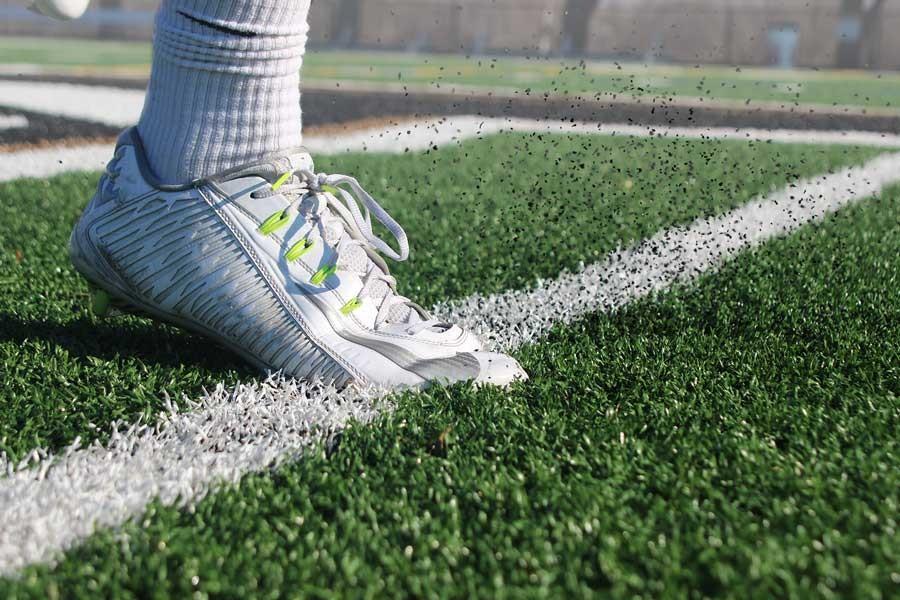Turf poses possible health concerns
Much debate has been going on about the health risks surrounding synthetic turf after an NBC investigation linking turf exposure to cancer. According Director of Facilities Stewart Walker, JC’s fields are filled with 50 percent sand and 50 percent crumb rubber, and he states that the school looked into the recent concerns before implementing the turf fields.
Pellets of crumb rubber fly into junior Ellie Marts’s eyes and mouth as she dives to the save the ball from going into the goal. According to Marts, the varsity women’s soccer goalie, the turf “literally gets everywhere.”
However, it doesn’t bother her much, but maybe it should.
Recent concerns with artificial turf have led to a nationwide debate about what actually goes into these fields. This debate was sparked by an NBC News investigation, linking the filling in turf fields to cancer.
The NBC investigation featured two high-school female soccer goalies diagnosed with non-Hodgkin lymphoma in a hospital where a nurse had treated three other goalkeepers in the same week.
The report highlighted soccer coach Amy Griffin, who compiled a list of 38 American soccer players, 34 of whom were goalies, that had been diagnosed with cancer.
According to NBC News, while all athletes are exposed to these turf granules, soccer goalies in particular are in constant contact with them. Their position requires them to dive to the ground dozens of times per game, and with each dive, these granules can enter cuts, mouths, eyes, and other exposed parts of the body.
NBC acknowledged in its report that no research has linked artificial turf to cancer. The Synthetic Turf Council responded to concerns by saying that: “the evidence collected so far by scientists and state and federal agencies proves that artificial turf is safe.”
Marts has heard of these concerns regarding turf, but isn’t too worried. “I love playing on turf and have never felt like the turf would hurt me. I play on turf all the time, more than grass. I’m not really worried,” she said.
Marts is not alone. “I don’t really believe [in the controversy] too much because I don’t think the school would put us in a harmful situation like that,” junior varsity field hockey player and marching band member Anna Smith said.
Athletes who have played on turf are used to these bits of turf pouring out of their shoes, sticking to their socks, or, less often, being lodged into a mouthguard. “[It’s in my] eyes, mouth, and all over my clothes after games [and] practices,” Marts said.
For some, the turf is just a part of the game. “Yeah, I mean it [turf] gets everywhere, but it doesn’t bother me too much,” senior varsity men’s soccer player Spencer Langbein said.
Last year, JC installed two new turf fields. They cost approximately $1.3 million, one million of which was raised through donations.
So what is in our turf?
The Patriot contacted Athletic Director Steve Teter to find out what was in the turf. Teter directed questions to Director of Facilities Stewart Walker.
According to Walker, the fields are filled with 50 percent sand and 50 percent crumb rubber. This is considered the most cost-affordable option for multi-sport play.
Walker states that the school looked into the recent concerns before implementing the turf fields, and considering there was no empirical evidence condemning synthetic turf to be harmful, went ahead with the installation.
The company that supplied the turf for the fields is Field Turf.
On the company’s crumb rubber information page, a link cites studies from sources such as the Environmental Protection Agency and various state agencies, all of which affirm the lack of evidence for any health risks associated with crumb rubber.
Head Athletic Trainer Erik Fabriziani is aware of the concerns regarding synthetic turf and cancer and feels it’s just “one of those things where someone has taken their own experience and compiled their own evidence. It’s not scientific.”
Fabriziani feels that without the scientific evidence, the benefits of turf far outweigh the negatives, and he isn’t worried. “I have no concerns [with synthetic turf] regarding cancer, and would let my kids play on it,” he said.
However, others have raised other concerns with turf besides possibly carcinogenic material: hygiene.
“I play at Du Burns [an indoor sports arena], and just last night, I was watching people spit and blow their nose on the turf like they would grass, but unfortunately there is no natural draining [in turf],” varsity women’s soccer coach Hayley Howe said. “That’s where my concern comes into it, not so much the rubber.”
However, students feel the turf is maintained well. “I think the turf has always been kept nice and clean. It has been perfect for us [in field hockey] and for band camp,” Smith said.
No studies have proven the harmful nature of synthetic turf, though according to Nature Nanostructure at the University of Edinburg/MRC Center for Inflammation Research in Scotland, inhaling “carbon nanotubes” (crumb rubber pieces) could lead to the same cancer and breathing problems that prompted a ban on asbestos as insulation in buildings.
The question remains: should we be concerned? While studies haven’t shown empirical evidence of the cause and effect relationship between crumb rubber and health risks, the correlations and concerns cannot be forgotten as synthetic turf continues to grow in popularity across the world.
Claire Grunewald is the Print Chief for The Patriot and jcpatriot.com.



